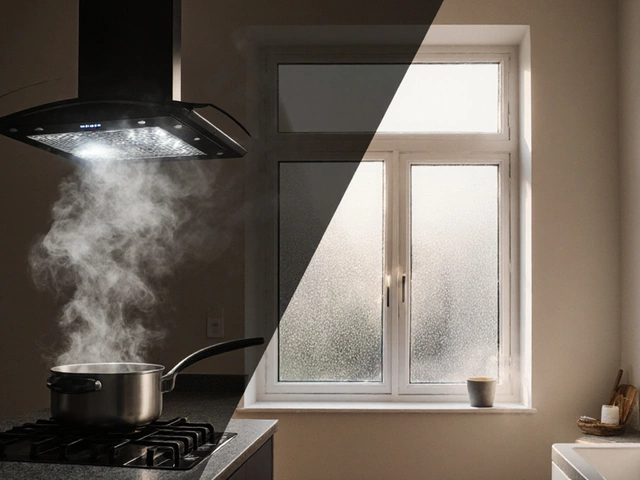So you're staring at that noisy, broken extractor fan in your bathroom or kitchen, and you're wondering if you actually need to call in an electrician or if you can just handle this job over the weekend. Maybe the fan's not sucking out steam, the light won't turn on, or the whole thing rattles like it's about to shoot off the ceiling. Either way, you want to fix it before mold takes over your walls or your bathroom gets that 'perma-damp' smell.
Before you grab a screwdriver and start pulling down the old fan, pump the brakes for a second. Extractor fans are plugged right into the mains electricity—a mistake here isn’t just a blown fuse, it's a potential shock or fire risk. Some setups are dead simple, others are wired into lighting circuits or timers. Understanding what’s behind that plastic fascia is step one if you want to stay safe and avoid a surprise visit from emergency services. Keep reading—this isn't just about swapping out one fan for another, it's about knowing where your personal DIY limit is, and when an expert really does make sense.
- Why People Want to Replace Extractor Fans
- How Extractor Fans Are Wired
- Can You Replace It Yourself?
- Situations Where You Need an Electrician
- Safety Tips and Common Mistakes
- What Happens If You Get It Wrong?
Why People Want to Replace Extractor Fans
No one dreams of replacing an extractor fan, but it’s often one of those jobs that sneaks up on you. For a lot of folks, it starts with an annoying noise—or no noise at all. The fan stops working, leaving steam and smells hanging around, and before you know it, your tiles get mold spots or your paint starts peeling.
The main reasons people decide it’s time for a swap usually land in these buckets:
- Extractor fan is broken—won’t spin, won’t start, or makes enough racket to wake the neighbors.
- Old models barely shift air, especially in homes with updated insulation and tighter windows. More steam means more chances for mold.
- Electrical safety worries when a fan starts to spark, short-circuit, or maybe gets too hot to touch while running.
- Bathroom or kitchen gets noticeably damp or smelly, even when the fan is "working," showing it's just not cutting it anymore.
- Looking to upgrade to energy-efficient fans (many newer ones use up to 70% less power and are much quieter).
- Moving into a new place and finding fans caked with gunk, dust, or who-knows-what from the last owner.
Here’s what usually drives people to ditch the old model:
| Reason | % of Homeowners (UK data, 2024) |
|---|---|
| Fan not working at all | 42% |
| Noise or vibration | 21% |
| Poor air removal (damp or odors) | 29% |
| Energy efficiency or smart upgrade | 8% |
A fan might look harmless, but if it isn’t clearing out moisture, your entire bathroom or kitchen can take a hit. Mold damages paint, grout, and even drywall. Plus, poor ventilation isn’t great for anyone with allergies or asthma.
There's also the new noise regulations—many buyers look for quiet extractor fans (under 30 decibels) when upgrading. If you’re trying to sell or just want to avoid complaints from the kids or partner, noise can be a deal-breaker.
So, swapping your fan isn’t just a cosmetic fix; it’s about keeping your home healthy and your stress levels low.
How Extractor Fans Are Wired
Extractor fans might look simple on the outside, but their wiring can get tricky under the hood. Most fans in bathrooms or kitchens are hooked up to your household’s 230-240V mains power, usually by spurring off the nearest lighting circuit. In older homes, you might find fans connected directly above the bathroom light, which means flipping on the light switch kicks the fan into action. More modern setups often use a separate isolator switch (a little pull cord or switch outside the bathroom), letting you turn the fan off without messing with the lights. That’s especially handy for maintenance or avoiding that midnight bathroom fan roar.
There are generally three types of extractor fan wiring setups you’ll run into:
- Standard 2-wire: Just a live and neutral wire, turning on and off with the light switch. This is the bare-bones version.
- 3-wire (with timer): Here, you’ve got a live wire, a neutral, and a switched live. The timer lets the fan keep running for a few minutes after you switch the lights off—super useful for clearing out steam or smells.
- Humidistat or sensor fans: These can have extra wires for sensors, letting the fan kick on automatically if humidity or smells spike up. The wiring is a bit more complicated here and usually flagged on the fan’s manual.
Messing up the wiring isn’t just annoying—it creates real risks, from tripping circuit breakers to sparking an electrical fire. Here’s a quick breakdown of what you might see when you check behind the cover:
| Wire Color (UK) | Old Wire Color | Function |
|---|---|---|
| Brown | Red | Live |
| Blue | Black | Neutral |
| Grey | Yellow | Switched Live (for timer fans) |
| Green/Yellow striped | Green/Yellow striped | Earth (Ground) |
Keep in mind: fans in bathrooms need to be rated for wet zones, and the wiring usually has to go through a 3-amp fuse for safety. If your wiring doesn’t look like any of this, step back—it’s probably time to call in an electrician.
Can You Replace It Yourself?
If you like a bit of DIY, swapping an extractor fan seems manageable—just unscrew the old one and fit the new one, right? Sometimes, yes. But it really depends on your setup and the local rules where you live. In the UK, for example, replacing a fan on a 'like for like' basis is allowed if you're not moving wires or changing anything about the circuit. If you're messing with wiring or you're in a “special location” (like your bathroom), the rules get a lot stricter. The same goes for Australia and the US—bathrooms and kitchens are sensitive areas. Mess up the wiring, and you could get a nasty shock or void your home insurance.
It's smart to check your fan's wiring before doing anything. Some fans are simply connected with plug-in cables; others are hardwired straight into a lighting circuit with timers or humidity sensors. If the wiring looks complicated, or if you're not sure what's what, it's time to call a professional.
- If the existing and new fans have the same voltage and size, and wiring connections match up, it’s usually a straight swap.
- If you need to run new wires or change where power comes from, that's a step up—most folks should leave this to a pro.
- Working in a bathroom? Local codes often require a licensed electrician, especially within certain distances of showers or baths (for example, in the UK within regulated “Zones”).
Here’s a quick breakdown of tasks you can and probably should not handle on your own:
| DIY Task | Safe to Do? | Extra Warning |
|---|---|---|
| Swap old fan for same model/size | Usually yes | Turn off power first |
| Replacing fan in a bathroom (same wiring) | Sometimes | May need electrician by law |
| Upgrading to a different type (e.g., timed or humidistat fan) | No | Needs new wiring—call an electrician |
| Moving fan to a new position | No | Needs new wiring—call an electrician |
| Wiring into a lighting circuit | No | Risk of shock/fire—call an electrician |
Don’t forget about safety. Always turn the power off at the breaker before touching anything electrical. Use a voltage tester to double-check it’s dead. Missing this step has caused more emergencies than you’d think. If you don’t really understand what each wire does, or your area’s laws require a pro, step back—no home upgrade is worth a trip to the ER.
And one last thing: if your replacement extractor fan comes with a warranty, DIY mistakes can void it. Some brands actually require a qualified electrician to install the fan for the warranty to be valid. So before you crack open that box, look for any fine print. When in doubt, getting an electrician involved is always the safer bet—especially when electricity and water are in the same room.
If you’re determined to do it yourself, here’s a basic checklist to see if you’re actually set up for a DIY fix of your extractor fan:
- You’re replacing the fan with an identical or similar model
- The wiring is already done, safe, and undamaged
- You’re outside of restricted zones (like within 60cm of a bath)
- Your local building codes allow DIY replacement
- You have the right tools and know how to use them safely

Situations Where You Need an Electrician
There are times swapping out an extractor fan turns into more than a quick DIY fix. Knowing when to pick up the phone and call a pro could save you cash, trouble, and a lot of headaches.
If you need to move any wires, reroute circuits, or cut into walls to add new cabling, you’re officially out of easy territory. In places like the UK and Australia, strict electrical safety laws say you can’t touch these jobs without certification. Even in the US, local codes often ban homeowners from modifying fixed wiring—especially around wet zones like bathrooms and kitchens.
- Extractor fan is connected to a lighting circuit or a timer: Messing with circuits you didn’t personally install can mess up other connected devices (like ceiling lights) or affect your home’s wiring in ways you can’t see. Electricians use electrical testers to check if circuits are safe.
- There's no isolation switch: If your fan can’t be safely switched off at a wall, don’t risk shocking yourself trying to work on a live wire. Electricians can fit a proper isolation switch, which is sometimes required by code.
- Wires look damaged or scorched: Signs of heat damage, burning, or melted insulation mean something went wrong. This is a big red flag—don’t touch it.
- New fan has different power requirements: Swapping a basic fan for something bigger (say, one with a humidity sensor or a heater) might overload circuits. Licensed electricians check load and make sure your wiring and fuse box can handle it.
- Your bathroom or kitchen is in a flat/apartment: In some places, blocks of flats require sign-off by an electrician for any electrical change, even the little stuff.
- You need to patch up/modify existing wiring: Cutting, extending, or splicing new wires together isn’t just tricky—it’s where most home electrical fires start.
If you’re thinking, “Well, I’ll chance it”—keep this table in mind. These numbers from US and UK fire services give a solid reason to err on the safe side:
| Issue | DIY Attempt (%) | Professional Install (%) |
|---|---|---|
| Electrical Fires (cause: fan install) | 43 | 7 |
| Shock Injuries (bathroom/kitchen work) | 28 | 3 |
| Failed Safety Inspection | 65 | 9 |
So, if your job ticks any of these boxes, don’t risk it—bring in an electrician. You’ll avoid hassle with insurers, pass inspections, and, frankly, sleep better at night knowing you’re not living over a hidden fire hazard.
Safety Tips and Common Mistakes
If you’re swapping out that extractor fan, safety isn’t optional. Electrical work is no joke—even a basic replacement can go wrong fast if you miss a detail. Each year, electrical accidents in UK homes send around 350 people to the hospital, and most of those are from jobs that seem simple at first.
- Turn Off the Right Circuit: Flicking the wall switch isn’t enough. You need to shut off power at the breaker box. Use a voltage tester on the wires before you touch anything. No guessing—double check!
- Label Wires Before Disconnecting: Most fans have several wires: live, neutral, earth, maybe even switched live for timers. Take a picture or use tape to mark each one. Mixing them up later is a common—and dangerous—mistake.
- Check for Damp and Leaks: Fans go in places with lots of moisture. If wires or connectors look rusty, replace them. Water and electricity don’t mix, period.
- Use the Right Tools: Don’t use kitchen knives or dodgy screwdrivers. Use insulated tools meant for electrical work. A tiny slip can equal a big shock.
- Fit the Fan Securely: Loose fans rattle, fall, and can yank their wires loose. Get the right size fixings for your wall or ceiling, and follow the manufacturer’s install guide.
- Buy the Correct Fan: Bigger isn’t always better. Look for the right air flow rating (measured in cubic meters per hour, or m³/h) for your room size. A weak fan in a big bathroom does nothing but waste electricity.
Here’s how common mistakes stack up, based on home insurance reports:
| Mistake | What Usually Happens | Approx. Incident Rate (%) |
|---|---|---|
| Power *not* switched off at breaker | Electric shock or fried new fan | 31 |
| Wrong wires connected | Fan doesn’t work, or keeps running nonstop | 24 |
| Ignoring earth/ground wire | Shock risk, fan fails safety check | 19 |
| Poor sealing against damp | Fan rusts, short circuits over time | 14 |
| Mounting not secured | Fan wobbles or damages plaster/tiles | 12 |
If you spot burned or melted wires, old wiring, or things don’t look like the install manual, stop and call an electrician. Spend an extra few minutes checking every step—nobody wants to be part of those accident stats.
What Happens If You Get It Wrong?
If you mess up replacing an extractor fan—especially if you skip the electrician—things can go south fast. Let's be real: on TV, DIY looks easy, but in real life, a simple mistake can cost way more than just replacing the fan again.
First, there’s your safety. Wiring an extractor fan to the main power means you’re dealing with live electricity. If you mismatch wires or fail to properly isolate the circuit, you could get shocked. The UK has about 350,000 home electrical shocks reported each year—no one wants to be part of that statistic. Getting the connections wrong might trip your breaker (if you’re lucky), but the real risk is something catching fire inside your walls weeks later.
Then there’s the legal side. In many places, including the UK, building regulations say you need a certified electrician for electrical work in ‘special locations’ like bathrooms. If you do it without following regulations, your home insurance might not cover any damage, and you could face trouble if you try to sell your place later.
Another thing people overlook: extractor fans play a big part in stopping damp and mold. If your new fan isn’t hooked up right, it could stop working—or work at half power. That means steamy bathrooms, peeling paint, and, eventually, mold or rot in your ceiling. Repairs like that can get expensive fast.
Here’s what can typically go wrong if you get the replacement or wiring wrong:
- The fan doesn’t turn on at all, or it keeps running even when switched off.
- Lights on the same circuit start flickering or fail completely.
- There’s a burning smell from the ceiling or wall—this is a red flag to turn off your power at the breaker immediately.
- Your extractor fan buzzes but doesn't pull air, hinting at bad wiring or a mismatched replacement.
Best tip: If you’re ever unsure about connecting a extractor fan, it’s way cheaper and safer to call in a pro than to gamble with your safety, home, or wallet.




